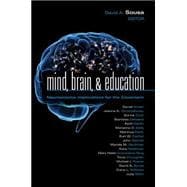Mind, Brain, and Education: Neuroscience Implications for the Classroom is the sixth book in the Leading EdgeTM series. The Leading Edge series unites education authorities from around the globe and asks them to confront the important issues that affect teachers and administrators the issues that profoundly impact student success.
Mind, Brain, and Education is a landmark publication in the emerging science of educational neuroscience. The leading researchers who contribute to the volume use neuroscience s growing knowledge of how the brain functions and develops to explore the field s implications for pedagogy and the classroom. The contributors investigate such questions as the following:
- What are the neurological foundations of learning and of individual differences in learning?
- How did educators get involved with neuroscience, and where might this involvement lead?
- What does neuroscience reveal about the brain s ability to use written and spoken language, to use mathematics, and to think creatively?
- How can educational neuroscience improve the teaching of these abilities?








